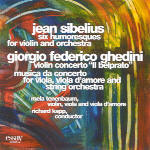This enterprising disc brings together some neglected but wonderful music. It’s hard to believe that complete recordings of Sibelius’ late six humoresques are so rare. They may be small individually, but taken together they comprise practically another violin concerto, and they are no less musically worthy. Mela Tenenbaum takes a marginally broader view of them than does Dong-Suk Kang on BIS, giving the music more room to breathe. She finds an extra grace in both of the G minor pieces, the Alla gavotta and Andantino, and her decision to reverse the order of the final two makes excellent sense. Richard Kapp and his Czech players offer finely detailed accompaniments, and the disc would be worth hearing for these works alone even if the couplings weren’t so interesting.
In his notes, conductor Kapp very aptly compares Ghedini’s music to that of Frank Martin. Both composers evolved fluent, somewhat understated, but nevertheless characterful musical styles steeped in the great traditions of the past (particularly with regard to matters of form), but employing an interestingly personal harmonic language. Ghedini’s Violin Concerto “Il belprato” consists of five linked movements lasting a bit over 17 minutes. It’s beautifully written for the soloist and the accompanying string orchestra, and Tenenbaum clearly relishes its challenges, particularly in the spunky outer movements. This is curiously compelling music, frequently quite dissonant but never excessively so, and always so shapely and melodically distinguished that the ear never feels fatigued.
Musica da concerto for viola, viola d’amore, and string orchestra is more fascinating still. Its single long movement divides naturally into two parts. In the first half, the soloist plays the viola, while in the darker hued second half she switches to viola d’amore. Perhaps the closest analog to this remarkably poetic piece would be Martinu’s similarly lyrical Rhapsody-Concerto, though Ghedini’s harmonies have a slightly bitterer tinge to them. Tenenbaum sounds just as comfortable playing her two violas as she does on the violin, and deserves credit as much for her enterprising choice of repertoire as for her versatility in playing it so well. Once again Kapp provides sensitive support from the podium.
The two Ghedini pieces were recorded in live performance and inevitably sport a certain amount of audience noise (never too distracting), while all of the works balance the soloist a bit too closely. Tenenbaum’s musicianship can withstand the scrutiny, but a more realistic balance would have made for more pleasing listening at higher dynamic levels. Otherwise, there’s nothing else to do but thank Tenenbaum and conductor Richard Kapp for coming up with such a distinctive and worthwhile program.
































